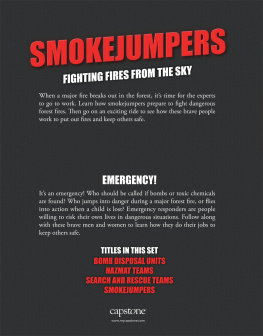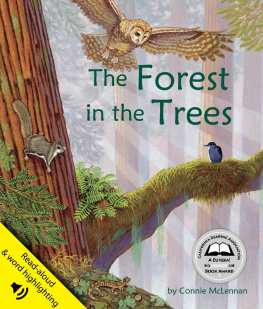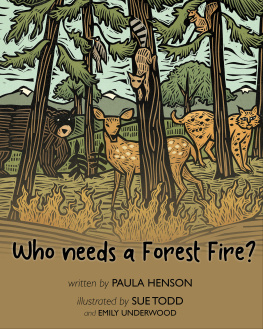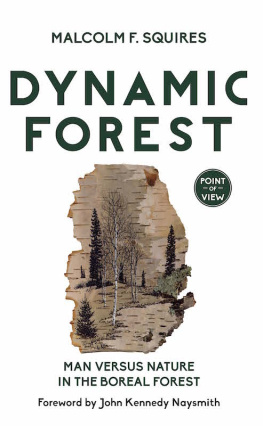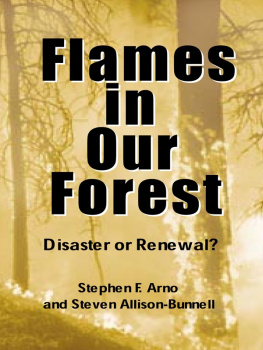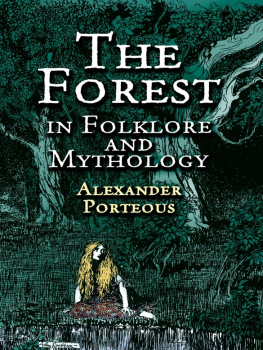Anita Ganeri - Forest Fire!
Here you can read online Anita Ganeri - Forest Fire! full text of the book (entire story) in english for free. Download pdf and epub, get meaning, cover and reviews about this ebook. year: 2006, publisher: Encyclopaedia Britannica;Britannica Digital Learning, genre: Home and family. Description of the work, (preface) as well as reviews are available. Best literature library LitArk.com created for fans of good reading and offers a wide selection of genres:
Romance novel
Science fiction
Adventure
Detective
Science
History
Home and family
Prose
Art
Politics
Computer
Non-fiction
Religion
Business
Children
Humor
Choose a favorite category and find really read worthwhile books. Enjoy immersion in the world of imagination, feel the emotions of the characters or learn something new for yourself, make an fascinating discovery.

- Book:Forest Fire!
- Author:
- Publisher:Encyclopaedia Britannica;Britannica Digital Learning
- Genre:
- Year:2006
- Rating:3 / 5
- Favourites:Add to favourites
- Your mark:
- 60
- 1
- 2
- 3
- 4
- 5
Forest Fire!: summary, description and annotation
We offer to read an annotation, description, summary or preface (depends on what the author of the book "Forest Fire!" wrote himself). If you haven't found the necessary information about the book — write in the comments, we will try to find it.
Forest Fire! describes how, why, and where forest fires happen.
Forest Fire! — read online for free the complete book (whole text) full work
Below is the text of the book, divided by pages. System saving the place of the last page read, allows you to conveniently read the book "Forest Fire!" online for free, without having to search again every time where you left off. Put a bookmark, and you can go to the page where you finished reading at any time.
Font size:
Interval:
Bookmark:

E-book published in 2012 by Encyclopdia Britannica, Inc., in association with Arcturus Publishing Limited, 26/27 Bickels Yard, 151-153 Bermondsey Street, London SE1 3HA. Britannica, Encyclopdia Britannica, and the Thistle logo are registered trademarks of Encyclopdia Britannica, Inc.
ISBN: 978-1-61535-650-8 (e-book)
This edition first published by Arcturus Publishing
Distributed by Black Rabbit Books
123 South Broad Street
Mankato
Minnesota MN 56001
Copyright 2006 Arcturus Publishing
All rights reserved
Library of Congress Cataloging-in-Publication Data
Ganeri, Anita 1961
Forest Fire! / by Anita Ganeri
p. cm -- (Natures fury)
Includes index
1. Forest fires--Juvenile literature. I. Title
SD421.23.G36 2007
634.9618--dc22
2006022607
9 8 7 6 5 4 3 2
Editor: Alex Woolf
Design: Minds Eye Design
Picture Research: Shelley Noronha
Picture credits:
Corbis: 4 (F. Krahmer/zefa), 5 (Jim Sugar), 7 (T. Allofs/zefa), 8 (Aim Patrice), 9 (Dr. Vic Bradbury), 10 (Tom Bean), 12 (Reuters), cover and 14 (J. Emilio Flores), 15 (Frank Lane Picture Agency), 16, 18 (Brian A. Vikander), 20 (Parrot Pascal), 21 (Viviane Moos), 23 (Reuters), 24 (Aim Patrice), 25 (Yves Forestier), 26 (John Heseltine), 27 (T. Allofs/zefa), 28 (Dale C. Spartas), 29 (Raymond Gehman).
FLPA: 17 (Michael Quinton/Minden Pictures), 19 (Jim Brandenburg/Minden Pictures).
Minds Eye Design: 6.
NASA Visible Earth: 11 (Jacques Descloitres, MODIS Land Rapid Response Team at NASA GSFC), 22 (Image by Robert Simmon, based on data from NASA GSFC, MITI, ERSDAC, JAROS, and U.S./Japan ASTER Science Team).
Science Photo Library: 13 (John Reader).
T he sight of a fire sweeping furiously through a forest is both frightening and spectacular. Forest fires (also called wildfires) are devastating events. Their intense heat burns leaves and branches to a crisp before making them explode, roaring and crackling, into flames. Giant flames leap hundreds of feet into the air, along with columns of thick, black smoke. In the biggest fires, spinning tornadoes are created by the rapidly rising heat.
A fiery path
Even the biggest forest fire starts as a tiny spark. If the vegetation is dry enough, the spark quickly grows into an inferno. Flames spread in all directions, burning everything in their path. They damage and kill trees, incinerate plants on the forest floor, and even kill roots underground. Buildings in the way are also burned. Any unfortunate people or animals who become trapped between the fast-moving flames may be killed by smoke. When the flames are gone, a charred, smoking wasteland is left behind. Firefighters do not attempt to put out intense forest fires. Instead they try to stop the fires from spreading and allow the flames to burn themselves out.

Flames raging through a coniferous forest in Yosemite National Park in California.
Where and why?
Forest fires happen in places where hot summer weather dries out dense vegetation. They happen more often during droughts. The dry vegetation catches fire very easily, allowing the fire to spread rapidly. Fire affects both coniferous forests and deciduous forests. It can also burn across grasslands, scrub, and brush. Most forest fires are started accidentally by people, but some are started naturally by lightning.

Scientists cutting a slice from a giant sequoia tree. The tree rings will tell them when forest fires happened in the past.
 A NATURAL CYCLE
A NATURAL CYCLE
Lightning has been starting forest fires throughout history. Layers of charcoal in rocks tell us that there were devastating fires millions of years ago. Blackened tree rings in very old trees show that natural forest fires are regular events in some places. Although forest fires can be very damaging, they are not always bad news. Fire clears out old trees and allows new ones to grow. There is a natural cycle of fire and regrowth. In fact, some species of trees could not survive without regular fires.
B efore we can investigate how forest fires burn and how firefighters combat them, we need to understand what exactly fire is. A fire is made up of glowing, red-hot material and often flames. These give off heat and normally produce smoke. Fire happens when a material burns. Burning is a chemical reaction between a material and oxygen, which is one of the gases in the air. Burning is also called combustion.
The fire triangle
A fire must have three things to keep burning. They are fuel, heat, and oxygen. These three things make up the fire triangle. A fuel is any material that burnsnot just the fuels we use for heating, in cars, and so on. You can find out about the fuels in forest fires on pages 13. Fuel must be heated before it will burn, and this heat must be provided for a fire to start. Once a fire is burning, however, it produces its own heat, and so it can keep burning. Oxygen comes from the air, so a fire needs a supply of air.

This diagram is known as the fire triangle. The elements on all three sides must be there for the fire to continue burning.
Flames and smoke
Plant matter, such as wood and leaves, is made up of several substances, including cellulose and lignin. When plant matter is heated, these substances begin to break up. Some flammable gases are given off. These burn in the air, giving off heat and light, which we see as flames. The material that remains is mostly carbon. Carbon glows red as it burns. Some tiny bits of unburned carbon are carried into the air. These mix with the air to form smoke. Water from the plant material boils in the heat, making steam that rises with the smoke.

A close-up of the intense heat in a fire. The tree bark is glowing as the carbon in it burns.
 STOPPING FIRE
STOPPING FIRE
If you remove one of the three sides of the fire triangle (fuel, heat, or oxygen), the fire cannot keep burning. So if the fuel runs out, the heat is taken away, or the oxygen supply is cut off, the fire goes out. These are the basic ways of fighting fire. Firefighters can stop a fire by taking away fuel, cooling it with water, or smothering it with foam.
T wo conditions are needed for a forest fire to start. First, the forest fuel (the trees, other plants, and dead matter on the forest floor) must be dry. Second, there must a source of heat to ignite the fuel and start the fire.
Where fires happen
Forest fires happen most regularly in parts of the world where winters are cool and wet and summers are hot and dry. This sort of climate provides good growing conditions for trees and other plants, so there is plenty of vegetation around. But in the summer the vegetation can dry out. Two of the worlds forest fire hot spots are western North America and southeast Australia, where there are thousands of fires every year. However, in severe droughts fires can even rage in tropical rain forests, where conditions are normally too wet for fires to start.
Next pageFont size:
Interval:
Bookmark:
Similar books «Forest Fire!»
Look at similar books to Forest Fire!. We have selected literature similar in name and meaning in the hope of providing readers with more options to find new, interesting, not yet read works.
Discussion, reviews of the book Forest Fire! and just readers' own opinions. Leave your comments, write what you think about the work, its meaning or the main characters. Specify what exactly you liked and what you didn't like, and why you think so.







